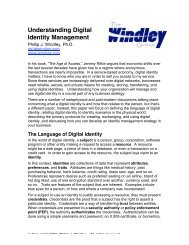Digital ID and eGovernment - Phil Windley's Technometria
Digital ID and eGovernment - Phil Windley's Technometria
Digital ID and eGovernment - Phil Windley's Technometria
- No tags were found...
Create successful ePaper yourself
Turn your PDF publications into a flip-book with our unique Google optimized e-Paper software.
transaction the same way that one presents it in the physical world. Of course,some means of authentication besides the picture would need to be used.I believe that homel<strong>and</strong> security is going to be a driving force in the use of thedriver’s license as a national identity document. The federal government isunlikely, for political reasons, to begin a national <strong>ID</strong> card program, but they couldforce states to use common st<strong>and</strong>ards, including smart cards, that would create ade facto national <strong>ID</strong> card system. For such a system to be useful for thingsbesides homel<strong>and</strong> security, a broad range of technologists will have to be involvedin its creation.<strong>Digital</strong> CertificatesNo paper on digital <strong>ID</strong> <strong>and</strong> <strong>eGovernment</strong> would be complete without a look atdigital certificates. Governments turned to digital certificates <strong>and</strong> their associateddigital signatures early on as a way to solve the digital <strong>ID</strong> dilemma. In truth, digitalsignatures have largely failed to deliver on their promise <strong>and</strong> most have stoppedlooking to them as a replacement for physical signatures. I think thatGovernment’s inability to clearly see its role in providing the foundational structurein digital identity is a significant contributing cause for this failure.Instead of recognizing the key role that they play in establishing identity in thephysical world <strong>and</strong> then seeking to play a similar role in the digital world,governments turned to commercial entities to create, authenticate, <strong>and</strong> sell digitalcertificates (i.e. act as certificate authorities).I argue that issuing digital certificates is a proper role of Government given th<strong>eGovernment</strong>’s obvious interest in identity <strong>and</strong> its de facto role in identity by issuingdriver’s licenses, passports, <strong>and</strong> other identity documents. Even so, no stategovernment has taken on the role of certificate authority. There are a few who areissuing digital certificates to their citizens, but they use a commercial certificateauthority to do so.I believe that this has been one of the primary causes for the spotty use of digitalcertificates in electronic government <strong>and</strong> commercial transactions. They areprohibitively expensive in many cases. This expense helps mitigate the risk thatcertificate authorities assume for misidentifying someone. Governments can (<strong>and</strong>frequently do) indemnify themselves against such risk <strong>and</strong> could issue digitalcertificates that are at least as trustworthy as the state issued driver’s license at avery low cost. In fact, such certificates could be routinely issued as part of theprocess of issuing a driver’s license if the license was based on smart cardtechnology.ConclusionGovernments have long played a role in identity in the physical world, but haveabdicated their responsibility in this area for digital identity. In the US we have ahealthy skepticism of government identity programs, which is one of the hurdlesgovernment involvement in digital identity will have to overcome. Even so, imaginewhat commerce in the physical world would look like if no driver’s license existed<strong>and</strong> states had never assumed responsibility for vital records. Certainly commerce






